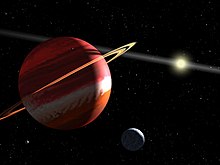Epsilon Eridani b
Epsilon Eridani b (also: Ægir ) is an extrasolar planet that orbits the main sequence star Epsilon Eridani . Due to its high mass , it is assumed that it is a gas planet . From the earth's point of view , Epsilon Eridani b, after Proxima Centauri b , is the second closest extrasolar planet to date. It's just over ten light years away.
discovery
Since Epsilon Eridani is one of the closest of the sun-like stars, intensive searches have been made for orbiting planets. The strong activity and variability of the star made it difficult to find it with the methods of radial velocity . It has been argued that star activity can also fake the presence of planets. In addition, the low metallicity of the system (about half that of the solar system) reduces the chance of planet formation.
As early as the early 1990s, the existence of a satellite was assumed by a Canadian team led by Bruce Campbell and Gordon Walker. However, their observations were not sufficiently sound to prove its existence.
In 2000, the discovery of the planet Epsilon Eridani b was formally announced by a team led by Artie Hatzes . The discoverers determined its mass as 1.2 ± 0.33 times the mass of the planet Jupiter .
Other researchers (including Geoffrey Marcy ) asked for more information about the star's Doppler effect, which is caused by its large and varying magnetic field. The discovery initially remained controversial. Eventually, additional observations from the Hubble Space Telescope , which increased the observation time to nearly 15 years, confirmed the exoplanet's existence. In early October 2006 this was published by Fritz Benedict of the University of Texas at Austin and his colleagues.
Track properties
Epsilon Eridani b orbits Epsilon Eridani with a period of 6.85 years at a mean distance of 3.39 AU, whereby the orbit should have an eccentricity of 0.7 according to the last calculation , which would be one of the largest values among the known exoplanets . He would be classified as " Eccentric Jupiter ". Its orbital plane is inclined by 30.1 degrees from the line of sight - and thus exactly matches the inclination of the gas and dust disk around the star. He reached the last Apastron in September 2010. One orbit lasts 2502 earth days, so almost seven years.
| Mass (in Jupiter masses) |
Circulation time (in days) |
Semi-major axis ( AE ) |
eccentricity |
|---|---|---|---|
| 1.55 ± 0.24 | 2502 ± 10 | 3.39 ± 0.36 | 0.702 ± 0.039 |
Physical Properties
Since the angle of inclination of the orbital plane and the radial velocity variation of the parent star are known, the mass of Epsilon Eridani b can be set at approx. 492.7 Earth masses or 1.55 Jupiter masses. It is very likely a gas giant and consists mainly of light elements such as hydrogen and helium. Should the high eccentricity be confirmed, Epsilon Eridani b would be exposed to strong fluctuations in the insulation . As a young planet, it is unlikely to form ammonia clouds; its upper atmosphere is probably characterized by water clouds.
Individual evidence
- ^ Artie Hatzes et al .: Evidence for a Long-period Planet Orbiting Epsilon Eridani . In: ApJ. Letters . 544, 2000, p. L145.
- ^ Fritz Benedict et al .: The Extrasolar Planet ε Eridani b: Orbit and Mass . In: The Astronomical Journal . 132, No. 5, 2006, pp. 2206-2218. bibcode : 2006AJ .... 132.2206B . Retrieved November 16, 2008.
Web links
- eps Eridani b (English) - Entry in Extrasolar Planets Encyclopaedia
- epsilon Eri b - Entry on Planet.ch ( Memento from July 1, 2014 in the Internet Archive )

